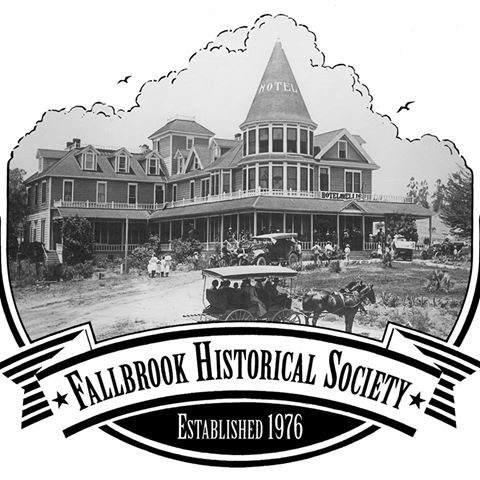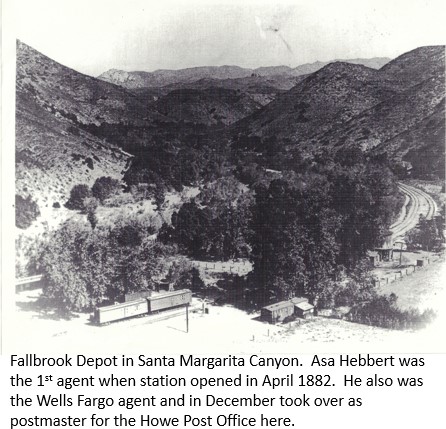Asa Hebbert
The first California Southern Railroad agent and also the Wells Fargo agent at the new Fallbrook train depot in 1882 was a recently arrived Civil War veteran named Asa Hebbert. [1]
After the Civil War ended in 1865, many Union veterans were among West Fallbrook’s earliest settlers. Fourteen are buried at the historic Odd Fellows cemetery[2], including Medal of Honor recipient Rev. William Pittenger. The Abbott brothers, two more Union veterans who built the Oddfellows Hall,[3] are buried in Santa Ana where they had other family. All of these men were leaders that made important contributions in early Fallbrook.
Asa Hebbert was born in the State of Maine in 1828. As a young boy, he and his parents emigrated to the far West, to the State of Illinois. Then at age 22, Asa caught gold fever and became a 49er. After a few years in the gold fields of California, Asa Hebbert returned to Moline, Illinois where he met and married Miss Jerusa Fairchild. He and his wife moved west to Wisconsin to become farmers. When the Civil War broke out in 1861, Asa enlisted into the 38th Wisconsin Infantry with the rank of first sergeant, probably because at age 29 he was older than most recruits. Asa was later promoted to lieutenant. After the war, the Hebbert family went West. In 1882, Asa and his family settled in what would later be called Fallbrook, taking a job as station agent with the new California Southern Railroad. He was appointed agent for Wells Fargo too. A few months later he added postmaster of the Howe post office to his duties. The Howe post office was at the train station. Hebbert, his wife, and their 3 daughters are all buried in the Hebbert plot in Fallbrook Oddfellows Cemetery.
William Crombie
The first headstone carving business in Fallbrook was set up by a Civil War veteran named William Crombie. Prior to Crombie’s arrival in 1910, professionally carved granite or marble headstones had to be ordered from San Diego.
William Crombie Jr. was born in Scotland in 1838, immigrating with his parents to the U.S. as a small child. As a young man, he learns how to sculpt stone and to play the violin. William is working as a sculptor in Massachusetts at the start of the Civil War. at the age of 23 he enlists in the Union Army, with the rank of private, as a musician. In the Civil War, music plays an important role. Both Union and Confederate armies had brass bands; bugles, drums, and fifes were played to transmit marching orders to the troops and to entertain the camps in the evening.
Later in the war, Crombie is commissioned as a lieutenant of Company D in the 14th Regiment of Colored Heavy Artillery. Colored meaning African-American. Following the war, Crombie returns to being a sculptor in civilian life and marries Miss Mary Ellen Dobbin in Portland, Maine. They have 7 children.
After his wife passes away in 1910 in Massachusetts, 72-year-old William Crombie decides he will accompany his widowed 68-year-old sister Elizabeth Findlay to Fallbrook, California to see her daughter and grandchildren. Elizabeth’s daughter Annie Findlay has 3 children with her husband John William Ormsby, a Bonsall pioneer. In Fallbrook, Crombie and his sister live together. Crombie sets up a small business carving headstones. He also gives violin lessons. Crombie joined the Oddfellows lodge and participated in veteran events. William Crombie is in the process of setting up a high school orchestra in September 1911 when he suddenly passes away of heart failure at the age of 73. His sister buries him and she remains in the Fallbrook area to be near her daughter’s Ormsby family. She becomes known as Grandma Findlay by everyone[4]. When Grandma Findlay passed away in 1930 at the age of 93, she was buried in the Fallbrook Oddfellows just a few feet from her brother, William Crombie.
Tom Frew
FHS Historian
[1] Asa Hebbert obituary, Moline Daily Dispatch, pg 2, 20 November, 1905, Moline Illinois.
[2] Jerry Sayre, Sons of Union Veterans, Sgt. William Pittinger Camp 21 of Fallbrook, CA.
[3] See The History of Odd Fellows Hall, Fallbrook Historical Society.
[4] Ormsby Story, Fallbrook In Review, vol. 1, page 27.




